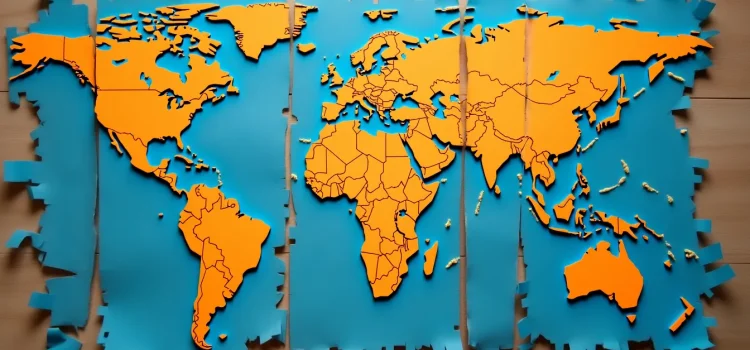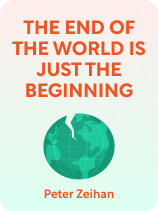

This article is an excerpt from the Shortform book guide to "The End of the World Is Just the Beginning" by Peter Zeihan. Shortform has the world's best summaries and analyses of books you should be reading.
Like this article? Sign up for a free trial here.
What’s “deglobalization”? In what way is it a new world order?
According to Peter Zeihan, deglobalization is on the horizon because our current interconnected world is a house of cards. In his book The End of the World Is Just the Beginning, he describes a future of regional economies, resource scarcity, and widespread disruption.
Read more to get Zeihan’s analysis of deglobalization and the challenges we might face on the road ahead.
Peter Zeihan on Deglobalization
According to Peter Zeihan, deglobalization is in our future. This is because the pillars that support globalization—cheap energy, low-risk transportation, and stable supply lines for manufacturing and food—are crumbling.
The fall of the Soviet Union marked a turning point for globalization, as the US’s primary reason for maintaining international security disappeared. Although the US hasn’t completely abandoned its role as global protector, it has become increasingly difficult to justify this position to itself and its citizens. While the relaxed global tensions following the Cold War were a boon for most countries—resulting in a free-for-all of worldwide economic expansion—Zeihan argues that this era was the peak of globalization, and its gains aren’t sustainable because of their overdependence on the US ensuring peaceful global trade.
(Shortform note: While Zeihan asserts that global order rests entirely on the US’s shoulders, Gen. H.R. McMaster is highly critical of this perspective, referring to it as “strategic narcissism.” In Battlegrounds, McMaster argues that assuming US policy decisions are the main driving force behind global events is detrimental both to the US and to other nations. Strategic narcissism prevents policymakers from seeing other nations as independent agents with their own motivations or ability to make decisions. McMaster contends that because of this distorted worldview, the US and its allies are losing influence on the global stage at a time when their knowledge and resources are needed most.)
Consider: Many countries are now so heavily specialized in producing particular goods and services for export that most parts of the world can’t provide for themselves if global trade is disrupted. This is Zeihan’s nightmare scenario—that a major blow to international trade will start a chain reaction that topples society on a global scale. Zeihan predicts a sequence of events that will pull the world’s globalized economy apart—the population in key regions will decline, the world will break up into regional factions, and it will become more difficult to transport oil and food where they need to go.
(Shortform note: The potential calamity Zeihan sees in our future may have already happened once before, during a period known as the Bronze Age Collapse. In 1177 BC, Eric H. Cline attributes the sudden simultaneous downfall of Late Bronze Age civilizations to a confluence of military, economic, and natural disasters, including a breakdown of the vital trade networks that spanned the Near and Middle East. Because of how interconnected the societies of that time had become, from Greece and Egypt to Afghanistan, they were vulnerable as a whole to regional disruptions such as climate disasters and foreign invaders.)
Demographic Collapse
Zeihan suggests that declining populations in the developed world will trigger economic crises around the globe. The process began when more people moved from rural areas into cities—space for families became smaller, birth rates slowly dropped, and medical advances extended people’s lives. The combination of longer lives and fewer children led to our present-day aging population, and though people with fewer children to provide for can increase their savings and investments, boosting the capital fueling economic growth, there are fewer young people to reap the benefits. In short, economic growth isn’t sustainable if the population dwindles, and extended lifespans can only offset a reduction in birth rates for a limited time.
As more people retire from the workforce, there are fewer young workers to replace them, and as the larger, older generation passes away, the precipitous population drop that follows will come as an economic blow to the system. Zeihan argues that China in particular is at the highest risk for a demographic implosion due to its decades-long one-child-per-family policy, and when the Chinese workforce disappears, its economy will crack under the strain. Since China and other East Asian countries are vital to globalized manufacturing, the world will feel the brunt as the number of Asian workers decreases and the cost of their labor goes up.
Zeihan says that only a few countries, including the US, have industrialized and urbanized without seeing a drop in population. While the US will feel a demographic shock as the Baby Boomers (born 1946-1964) retire, the Millennial generation (born 1981-1996) is large enough to potentially carry the country through the 2040s. However, other countries face population reductions that may prove lethal to their economies. In tandem with the workforce reduction, people who retire draw their money out of investments, which decreases the economy’s credit supply, making it harder to fund new enterprises. Moreover, a shrinking labor force also means a smaller tax base, leaving governments strapped for cash to spend on public services.
A Planet Divided
As the world’s population and economy shrinks, the delicate balance of globalized trade will start to come apart at the seams. Zeihan warns that, if the US stops protecting international shipping, then vital trade routes will be vulnerable to local wars and international piracy. Transporting goods will be hazardous again, and the reliable flow of trade between countries could suddenly come to a halt. Zeihan writes that the US is already pulling out of its protective role because the lack of a military threat (such as the Soviet Union posed) and the US’s newfound energy independence make continuing its post-World War II strategies harder to justify internally. However, its policing role is one that no other country is poised to take on.
Because of this, vital shipping lanes throughout the world could become bottlenecks that throttle international trade and production. Zeihan cites East Asia in particular as a significant danger zone—the seas there are some of the world’s busiest shipping corridors, providing crucial links in manufacturing chains, but many East Asian countries are openly hostile to each other. Any outbreak of violence in the region could lead to disaster for all.
| Contemporary Threats to Global Shipping Zeihan highlights the Persian Gulf and the seas of East Asia as potential danger zones, but at the time of this writing, the chief trade route under threat is through the Red Sea and the Suez Canal, due to the nearby conflict between Israel and Hamas. Two dozen countries, led by the US, formed a coalition to safeguard shipping in the region, under the aegis of Operation Prosperity Guardian. Nevertheless, many shipping companies have elected to reroute their ships around the southern tip of Africa. Meanwhile, on the other side of the world, traffic through the Panama Canal has been slowed since 2023 due to a drought that reduced the amount of water available to move cargo ships through the canal’s giant locks. At the same time, as Zeihan predicts, the US is struggling to maintain its role as the protector of global shipping. Its navy has shrunk from nearly 7,000 ships at the end of World War II to less than 300 today, straining its capacity to respond to multiple threats at a time when shipping is threatened in various regions. The US defense industry is hard-pressed to meet the demand for equipment, which—like everything else in a globalized world—relies on international supply chains. The situation is exacerbated by the US military’s recruitment problems, which may be further impacted by future demographic changes. |
No More World Order
If global trade retracts, the world is likely to break apart into regional economies where every commodity is lower in quality and more expensive than it was during globalization. Zeihan speculates that there may even be a return to old-style imperialism, in which stronger countries take over weaker ones to use as sources of goods and cheap labor. However, this approach may prove unworkable in the modern age due to the fact that with declining populations, wealthier countries won’t have enough young people to maintain a conquering army. What Zeihan finds more likely is that powerful countries will set up regional protectorates to safeguard access to the resources they need.
However, as globalization unravels, the countries most dependent on imports and exports will take military action to secure their shipping lanes, which will likely involve measures against their regional rivals. Manufacturing chains will have to become much tighter and more localized than they are today. Zeihan predicts that piracy will resurge, sometimes by criminals, but often by nations desperate to access resources to survive. If that happens, then long-haul, heavy transport may die out, replaced by smaller, local transport vessels designed to outrun potential enemies. Countries with internal waterways, like the US, will fare better than those that are completely reliant on oceanic shipping routes.
(Shortform note: Modern-day piracy is a serious enough problem that maritime agencies provide regular updates on incidents and danger zones. In particular, piracy remains a constant threat near the coast of Somalia and in the South China Sea, both of which target high-trade regions that Zeihan highlights as being particularly important to global supply chains. Though as of this writing, there have been no modern reports of state-sponsored piracy, naval powers such as the US have boarded ships and seized cargo they deemed to be in violation of international law. A potential danger that Zeihan doesn’t mention is that of corporate-sponsored piracy, such as in 1990 when a company in Singapore was accused of hijacking several ocean-going vessels.)
| Is the World Really Breaking Apart? While there are some signs of the increasing regionalization Zeihan predicts, it’s too soon to determine if the trend will continue. However, there are several signs pointing to growing economic divergence between nations, such as increasing trade barriers, widening gaps in economic growth between regions, and a growing push for technological independence between major powers, such as the US and China. Most dangerous of all, geopolitical tensions in critical regions like Eastern Europe and the Middle East could—as Zeihan warns—break global supply chains and energy markets, forcing an emphasis on more regional economic cooperation. However, it’s important to note that the global economy remains highly interconnected. Despite the aforementioned challenges, the global economy continues to grow, with GDP growth accelerating in some regions. Institutions such as the International Money Fund (IMF) continue to emphasize the importance of international cooperation in addressing economic challenges—after all, inflation and climate change affect everyone and will require a united global effort to solve. Therefore, while there are some concerning trends toward regional fragmentation, the world economy isn’t breaking apart—yet. Instead, we’re seeing a complex interplay of global integration and regional divergence. |
Thirsty for Oil
While every commodity will be affected by restrictions on international shipping, those restrictions will compound themselves by limiting access to the resource that makes global transportation possible—oil. If international shipping falls apart, oil production will be drastically reduced, triggering an energy crisis.
The world’s dependence on oil for shipping means that any slight change in supply and demand can have dramatic effects on the cost of other goods. Zeihan anticipates a return to regional oil distribution markets similar to those of the imperial trading networks pre-globalization. Oil supplies will be restricted to whomever oil producers can safely ship it to. The US and Russia, with their internal oil fields, will be the least affected, but most of the world will suffer a severe energy crunch every time its oil deliveries are endangered. Since the US has enough oil for itself at home, it can no longer always be expected to protect the oil trade abroad.
Zeihan reminds us that fossil fuels like oil aren’t just used for transportation—natural gas generates electricity, and petrochemicals are the basis for many material goods, including medical supplies. Although “green” solutions are often proposed, they’re available only in countries with the right geography and climate. Renewable energy generation requires a lot of space and special conditions, and the cost for retooling our entire infrastructure to adapt to renewables is staggering. Renewable energy and substitutes for petrochemicals simply aren’t ready to replace fossil fuels at the scale we need, and the world will feel the coming oil shortages long before we have a viable substitute.
A Hungrier World
Zeihan says that the most serious threat from globalization’s downfall is that people won’t have enough food. The reason for the shortage will be simple—billions of people live thousands of miles from where their food is produced. Feeding them depends on cheap, reliable shipping, and, if that fails, so does the food supply. Densely populated cities depend almost entirely on imported food, and if trade breaks down, they can’t feed themselves. One solution may be to move people back to the countryside to work on farms, but many places in the world can’t support enough agriculture to sustain their current population. Therefore, Zeihan predicts that breakdowns in food production will lead to mass starvation, death, and the fall of governments.
However, disruptions to international commerce won’t just stop food from being shipped—farm equipment manufacturers won’t be able to get their machinery to the countries that need it, and if farmers can’t purchase equipment and keep it in working order, they can’t produce food in the first place, with or without a means to ship it. Additionally, Zeihan points out that the technology doesn’t exist to run heavy-duty farm equipment on anything but oil, which—as we’ve already discussed—will also be in short supply. Moreover, oil is a key ingredient in the pesticides that industrial farms use to keep their crops insect-free.
On top of all this, there’s climate change to deal with. Zeihan writes that with changing climate patterns, regions with abundant water and sunlight will become even more productive than before, but dry regions will become even drier, killing any hope of turning them into farmland. In some regions, climate change will alter rainfall patterns, such as by reducing the impact of monsoons that India and Southeast Asia depend on. In places where rainfall increases, frequent flooding will become a problem. The farmlands of the American Midwest may benefit from climate change and increase their yield, but overall, Zeihan says that the regions that increase their food production won’t offset the loss of arable farmland elsewhere in the world.
Exercise: Are You Worried About Deglobalization?
Zeihan presents a grim view—that every country in the world today is dependent on reliable international trade for its survival and well-being, a system that Zeihan says isn’t sustainable. Consider whether or not you believe Zeihan’s warnings are well-founded and how his predictions might affect you if they should come to pass.
- Think about the industry you work in—in what ways does it rely on international trade? What about the food you eat or the products you buy for your home—how would your personal lifestyle have to change if you no longer had access to imported goods?
- Zeihan predicts a demographic crisis as birth rates decline, leaving fewer young people to replace retirees. Where do you fit in this demographic wave? Do you expect to retire when you want, or do you think you’ll have to work longer than you’d hoped? If so, why?
- Zeihan believes the 2020s and ’30s will be difficult decades for the whole human race. Do you have specific fears for the near future? Are there changes or advances you’re hoping for that might alleviate some of the world’s current problems? If so, what are they?

———End of Preview———
Like what you just read? Read the rest of the world's best book summary and analysis of Peter Zeihan's "The End of the World Is Just the Beginning" at Shortform.
Here's what you'll find in our full The End of the World Is Just the Beginning summary:
- Why the golden age of international trade is about to end
- Why the collapse of international trade is the biggest threat to civilization
- How to prepare for tumultuous decades to come






